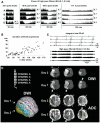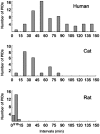Spreading depolarizations cycle around and enlarge focal ischaemic brain lesions
- PMID: 20504874
- PMCID: PMC2892938
- DOI: 10.1093/brain/awq117
Spreading depolarizations cycle around and enlarge focal ischaemic brain lesions
Abstract
How does infarction in victims of stroke and other types of acute brain injury expand to its definitive size in subsequent days? Spontaneous depolarizations that repeatedly spread across the cerebral cortex, sometimes at remarkably regular intervals, occur in patients with all types of injury. Here, we show experimentally with in vivo real-time imaging that similar, spontaneous depolarizations cycle repeatedly around ischaemic lesions in the cerebral cortex, and enlarge the lesion in step with each cycle. This behaviour results in regular periodicity of depolarization when monitored at a single point in the lesion periphery. We present evidence from clinical monitoring to suggest that depolarizations may cycle in the ischaemic human brain, perhaps explaining progressive growth of infarction. Despite their apparent detrimental role in infarct growth, we argue that cycling of depolarizations around lesions might also initiate upregulation of the neurobiological responses involved in repair and remodelling.
Figures






References
-
- Aitken PG, Tombaugh GC, Turner DA, Somjen GG. Similar propagation of SD and hypoxic SD-like depolarization in rat hippocampus recorded optically and electrically. J Neurophysiol. 1998;80:1514–21. - PubMed
-
- Astrup J, Siesjo BK, Symon L. Thresholds in cerebral ischemia - the ischemic penumbra. Stroke. 1981;12:723–5. - PubMed
-
- Back T, Ginsberg MD, Dietrich WD, Watson BD. Induction of spreading depression in the ischemic hemisphere following experimental middle cerebral artery occlusion: effect on infarct morphology. J Cereb Blood Flow Metab. 1996;16:202–13. - PubMed
-
- Brint S, Jacewicz M, Kiessling M, Tanabe J, Pulsinelli W. Focal brain ischemia in the rat: methods for reproducible neocortical infarction using tandem occlusion of the distal middle cerebral and ipsilateral common carotid arteries. J Cereb Blood Flow Metab. 1988;8:474–85. - PubMed
-
- Busch E, Gyngell ML, Eis M, Hoehn-Berlage M, Hossmann KA. Potassium-induced cortical spreading depressions during focal cerebral ischemia in rats: contribution to lesion growth assessed by diffusion-weighted NMR and biochemical imaging. J Cereb Blood Flow Metab. 1996;16:1090–9. - PubMed
Publication types
MeSH terms
LinkOut - more resources
Full Text Sources
Other Literature Sources
Medical

